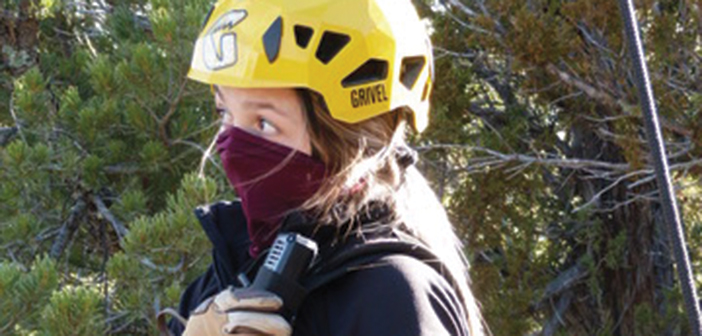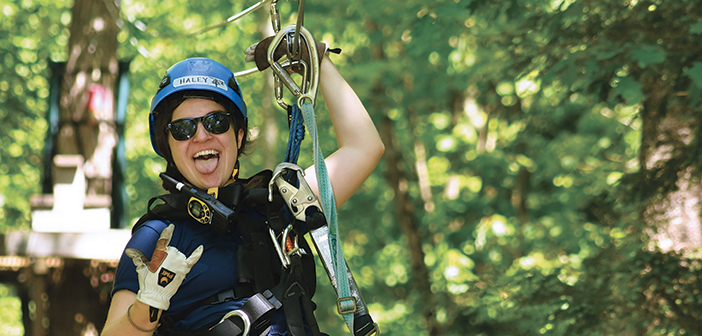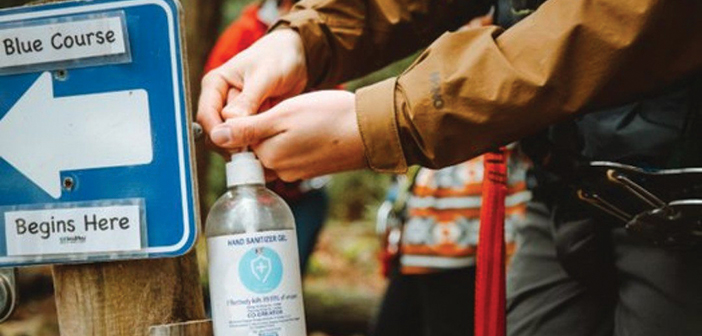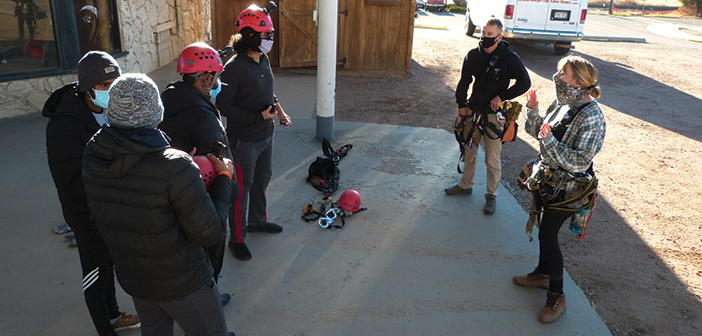Just over a year ago, in late winter 2020, most of the world started asking a lot of questions about SARS-CoV-2, aka Covid-19. How do I get it? How do I protect my family? How do I go to work or run my business? After a few months of sweeping upheaval to life as we know it, we all started asking the same question: When can we get back to normal?
In the outdoor recreation and aerial adventure community, this question loomed especially large. Many of our methods and business models were suddenly unsafe at any speed. When presented with a world where everything is six feet apart and behind a mask, we all started asking a new question: Can we really do this at all?
Without specific guidance from regulators, we relied as an industry on our collective exercise in a broad range of acceptable practices, methods, and interpretations of standards. Through hard work and collaboration, our industry came up with solutions for training and operations that were new and different for most of us, and we didn’t know how it would go. There’s a risk to changing practices under any circumstances, but the pandemic left us with no choice. So, we aimed to carefully and minimally modify existing practices, or make new ones that were both effective and scalable.
Here are some of the things we tried, and the key takeaways that will help form our “new normal” in 2021 and beyond.
Teaching Facilitation Skills
In a world of conflicting information, the methods we use to inform our trainees, staff, and clients have become even more important. “Facilitation” played a large role. While it can be a fuzzy concept at times, facilitation can be defined as the ways in which we engage our trainees, staff, and guests in discovering and applying learning insights.

A guide radios her teammate at Royal Gorge Zip Lines in Colorado.
Facilitation is a cornerstone of the aerial adventure industry. However, there’s debate as to whether this “soft skill” is important at high-throughput adventure parks, or as important as the tactile “hard skills” on which we spend the bulk of our training time.
The pandemic proved that facilitation skills are vital for staff at all types of operations. Nowadays, a sneeze or runny nose can create an immediate atmosphere of concern within a group, so the ability of all trainers and staff to facilitate conversations about health is mandatory. And it goes well beyond that.
As a trainer, I now start every session with a guided discussion around Covid-19, and the ways we’ll navigate our protocols during training and with the public—when and where we can take off masks, how and when to wash and sanitize hands, and most importantly, how to facilitate discussions with staff and the public about the precautions we’re asking them to take. This skill has obvious extensions past navigating discussions about masks
and handwashing.
Most supervisors and managers have memories of negative customer service situations that could have been avoided if the staff member had a few more discussion or conflict resolution tools. Spending more time teaching others to facilitate these discussions has been very beneficial. Plus, this skill will
provide added value in many other areas of operation after Covid-19 is a distant memory.
Better (and Digital) Materials
It was either Aristotle or a boss I had at a college telemarketing job that said: “Tell ‘em what you’re going to tell ‘em; then tell ‘em again; then tell ’em what you told ‘em.” Easier and less expensive digital resources have allowed us to get written and video training materials, waivers, and Covid policies in front of trainees and guests early and often.
Whether delivering a training or dealing with guests at your adventure park, a document or video outlining what your policies and expectations are is key to success. Many trainers updated their materials or created new ones to reflect the “new normal.”
This applies to adventure operations, too. It never hurts to review and/or update pre-course information and training materials anyway, so this was a great opportunity to update these and create new ones aimed at helping trainers and clients navigate the fluid environment of the pandemic.

Enjoying a rappel at The Gorge in North Carolina.
Increased use of digital waiver systems, “live documents” that can be updated with new information in real time, and easier-to-distribute video platforms have helped to minimize in-person time spent. This allows us to spend our now riskier in-person sessions on things that can’t be replaced by a digital document or virtual classroom.
“Using pre-training Zoom meetings to manage client expectations around training outcomes worked really well,” says Experiential Systems training director Andrea Vogt. “Setting the expectation early and in multiple formats makes facilitating conversations easier for trainers and staff alike.”
The inherent efficiency in this makes for another strategy we’ll continue to employ as we move forward.
Physical Distancing
The best way to mitigate the spread of Covid-19 remains physical distance from other humans. This is a challenge for many of us who are used to close, face-to-face interactions. Though I’m used to projecting my voice when I speak, doing so across a space that is now much larger was surprisingly difficult.
Another issue: Participants in training and aerial course operations tend to become comfortable with each other quickly, so it’s easy to forget that we need to keep our distance.
Using tools like cones, ropes, floor decals, and other props to help indicate where to stand is helpful, but isn’t a cure for this problem. For many elements, such as zip lines and big swings, “up close and personal” loading, unloading, and pre-flight check procedures require a certain proximity.
Removing or changing these hands-on methods poses significant risk, so this is an area in which I now ask myself the following questions:
Is this something I can model at a distance?
Can participants be coached to perform this task?
How do I ensure the operation is done correctly?
This facilitated approach to training and operations minimizes the time spent within an individual’s physical “bubble.” For example, putting someone in a harness can be just as efficient with little to no physical contact by modeling the operation, coaching the participant one step at a time, and having multiple methods for them to demonstrate that it’s correctly secured. There may still be a need to approach and physically interact with them, but hopefully for less time and with less contact than before.

A guide zips (pre-pandemic) at Zoar Outdoor in Massachusetts.
There are other benefits to lowering our frequency of physical contact with participants. If a person has issues with consent and touch, for example. By developing alternative methods of demonstration and creating new procedures that can be done at a distance, the person feels much more comfortable with the process.
Some pieces of operating at a distance, like facilitated approaches to harnessing and checks, will become common practice post-Covid. But dispersing my group across a field during a lecture or demonstration is something I’ll be glad to see in the rearview.
Masks
The benefits of wearing masks to mitigate the spread Covid-19 and other diseases is well documented. Proper use of masks remains a challenge, though we’re all getting better at facilitating conversations around it. When a simple, inexpensive item like a disposable surgical mask can be so effective, I’m looking to continue using these in the future.
The time will come when universal masking will no longer be required. But I do plan on training my staff to always employ one when in very close contact, such as during a rescue. Trainers and operators alike all have memories of a “staff plague” taking down an entire operation. When something as simple as wearing a mask can reduce the spread of illnesses, it makes sense to have them on hand for all future operations.

A hand-sanitizing station at WildPlay Nanaimo in British Columbia.
Some tips for operating with masks:
Not all masks are created equal! Buff and other manufacturers of neck gaiters have specific recommendations and criteria for use. Be sure to verify you’re using these effectively.
Fit is not universal. Most people who have trouble wearing masks just don’t have one that fits well. Have a variety of sizes available, and schedule time for people to fit them.
Operating in a mask is a challenge—but it gets a lot easier with practice. Schedule time to practice your procedures in masks; otherwise, you may find yourself out of breath and sweaty.
Reusable masks get gross fast and need to be cleaned often. It’s helpful to have an extra for a midday change-up.
Cleaning and Disinfecting Equipment
“Whatever the jurisdictional requirement becomes, it’s been great to see more care shown to equipment in general,” says Rich Petteruti of The Adventure Guild. “A key risk-management philosophy is taking care of the things that care for you. When you can build that mindset in operators, they tend to take a little more care with everything they do on a course.
“When I see an operator whose equipment is clean, organized, and well managed, it gives me the impression they’ll do a better job across the board.”
At the beginning of the pandemic, equipment care was a hot and controversial topic. How could we possibly sterilize everything we need between each use? As we move forward, we have more data that suggests contracting an illness from a harness or lanyard, while possible, is a lot less likely than we feared. While I’m still seeking to minimize sharing of equipment, I’m now less worried about using a harness with different people within the same day.
This shift in thinking has allowed for a more balanced approach to equipment management, setting regular schedules for cleaning equipment in line with the manufacturer’s criteria. We’re cleaning gear more often, but not trying to disinfect after each use. I am now reserving disinfection practices for times when I think something has been contaminated.

A masked guide at The Forge: Lemont Quarries demonstrates the belay system.
I’ll keep this practice forever. After all, I’ve always preferred to use equipment that looks and feels clean. And I’m not alone. It’s much easier to convince most people to wear a helmet when it smells like soap, not like sweat and sunscreen.
Cleaning Course Components
“Trying to scrub down wood surfaces that were already in the sun was frustrating and felt ineffective,” recalls Experiential Systems’ Vogt. When we knew less about surface transmission early in the pandemic, many of us were hand wiping or pressure-washing climbing surfaces and course components, which was hard to manage.
The CDC has since said that “Covid-19 spreads less commonly through contact with contaminated surfaces.” Rigorous cleaning practices now may fall more into the category of “feels effective” as opposed to “is effective.” I’m moving away from this procedure in 2021, in favor of increased hand washing and regular use of hand sanitizer—practices that continue to be very effective at stopping the spread.
Keep It Going
Given the circumstances, the aerial adventure industry fared pretty well in 2020. Many operations were able to open successfully and persevere. Although we now have a much better understanding of how Covid-19 spreads, one thing is abundantly clear: Our approaches to training and operating will need to continue evolving—and those changes can have lasting positive effects on the industry as a whole.
“The thing I enjoyed seeing most last year was an increase in understanding that the health and safety of us all relied on all of us doing our part,” says ERi CEO Mandy Stewart. “Things like pressure-washing climbing walls and wearing masks were hard, and it was great to see that people were still committed. People understood that this was what it would take for us to do the things we loved.”
Many of the practices we adopted in 2020 actually help us provide better experiences for both customers and staff. I plan to continue brainstorming and re-imagining my approach to every facet of aerial adventure trainings and operations. The goal: a “new normal” that continues to promote the healthy and sustainable growth of the entire industry.






